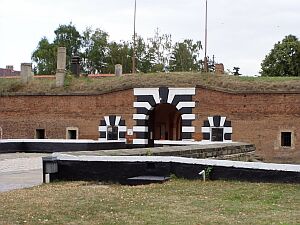Main article: Concentration camp Theresienstadt
During WWII, the Gestapo used Terezín, better known by the German name Theresienstadt, as a ghetto, concentrating Jews from Czechoslovakia, as well as many from Germany, the Netherlands and Denmark. Though it was not an extermination camp, of the 144,000 Jews who arrived there, about 33,000 died in the ghetto itself, mostly because of the appalling conditions arising out of extreme population density. About 88,000 inhabitants were deported to Auschwitz and other extermination camps At the end of the war there were 17,247 survivors.
Part of the fortification (Small Fortress) served as the largest Gestapo prison in the Protectorate of Bohemia and Moravia, separated from the ghetto. Around 90,000 people went through it, and 2,600 of those died there.
It was liberated on May 9th, 1945 by the Soviet Army.
 Terezín During World War II
Terezín During World War IIAfter the German surrender the small fortress was used as an internment camp for ethnic Germans. The first prisoners arrived on the 10th of may 1945. On the 29th of February 1948 the last German prisoners were released and the camp was officially closed. Among the interened Germans were on one hand former Nazis like Heinrich Jöckel, the former commander of Terezín or other SS-members. On the other hand a great group of internees was arrested simply because of their German nationality, among them young boys of 12 years or elderly people.
In the first phase of the camp lasting until July 1945 mortality was high due to diseases, malnutrition and incidents of simple outright murder. Commander of the camp in that period was Stanislav Franc, who had been a prisoner of the camp under the Nazis since 1944. He was guided by a spirit of revenge and tolerated any mistreatment of the prisonsers by the guards.
In July 1945 the camp shifted under the control of the Czech ministry for domestic affairs. New commander became Otakar Kalal. From 1946 on the inmates were gradually transferred to Germany and Terezín more and more turned into a hub for the forced migration of Germans form the Czech lands to proper Germany itself.
A small exhibition nowadays reminds of the history of Terzín as internment camp for Germans.
Exhibition dedicated to the interment camp Terezín
Terezín Today
 Lefthit
Lefthit
No comments:
Post a Comment